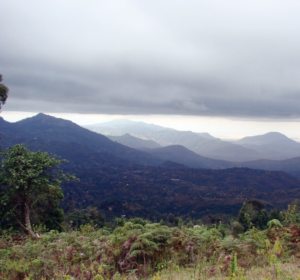
The Taita Hills in south-eastern Kenya (3º20’S, 38º20’E) rise abruptly to peaks ove 2,000 metres above the semi-arid plains of Tsavo. The hills contain some of the highest levels of endemism in the world, forming a key part of the Eastern Afromontane Biodiversity Hotspot. They also serve as a catchment for the expansive Tsavo ecosystem. Taita Hills also form the northernmost extreme of the Eastern Arc, a chain of forested mountains extending from Kenya to southern Tanzania.
Taita Hills forests Important Bird and Biodiversity Area (IBA) are part of BirdLife International’s Tanzania-Malawi Endemic Bird Area. The hills harbor the montane cloud forest whose vegetation is much influenced by both Eastern Arc and Kenyan highlands.
Biodiversity
Despite losing about 98% of forest cover in the last 200 years, the remaining Taita Hills forest fragments continue to support a high number of endemics and unique flora and fauna, including Kenya’s most threatened birds: the Critically Endangered Taita Apalis and Taita Thrush. Other endemics include: the Taita Hills Purple-glossed Snake, the Sagalla Caecilian, the Taita Warty Frog, the Taita Blade-horned Chameleon and three endemic butterflies. The flora is also rich and full of endemism in these small and extremely fragmented forests, where more than 13 plant species endemic to Taita Hills occur. The hills are also home to the Vulnerable Taita Falcon and Abbott’s Starling, the Endangered Taita White-eye and the Near Threatened Southern Banded Snake-eagle.
Conservation
Dawida Biodiversity Conservation group (DABICO) is the Taita Hills IBA site support group. The group has 13 constituent groups and is involved in activities such as establishment of tree nurseries, beekeeping, handicraft, eco-tourism and butterfly farming. DABICO manages the Ngangao Forest community resource centre that was built through collaboration with Nature Kenya, the Taita Taveta Wildlife Forum and the Community Development Trust Fund. The resource centre offers environmental education to school children and is also a camping site for visitors.
Nature Kenya in partnership with DOF – the BirdLife Partner in Denmark, through funding from the Danish International Development Agency (DANIDA) through CISU (Civil Society in Development), has been running the “Integrating Livelihoods and Conservation – People Partner with Nature for Sustainable Living” program in Taita. The long term objective of the Program is to: reduce the destruction of forested IBAs and contribute to the realization of best participatory forest management practices for the benefit of all. To achieve the objective, the program is supporting the formation of two Community Forest Associations (CFAs) which is still ongoing. The program is also supporting groups engaged in livelihood activities such as beekeeping, fish farming, tree nursery, handicraft and butterfly farming.
